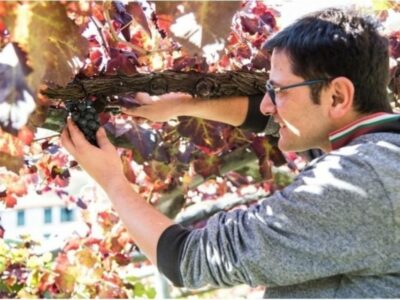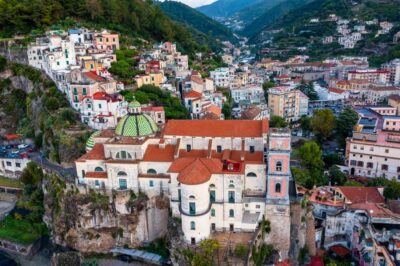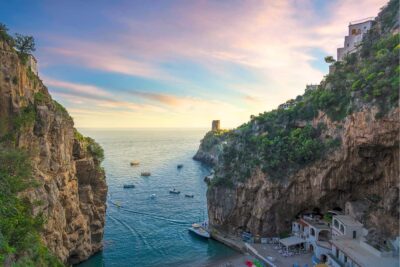A fissure in the rock, immersed in a wild nature that frames a small beach of just 25 metres: this is how the Fiordo di Furore appears, a small natural jewel in the heart of the Amalfi Coast.
Anna Magnani and Federico Fellini fell in love with this evocative corner: it was 1948 and the filming of ‘L’amore’ was underway. , a film in two episodes emblematic of the poetics of director Rossellini, who at the time was involved in a love affair with the actress.
And thousands of travellers still fall in love, capturing and sharing the famous suspension bridge over the fjord in amazement and wonder on social media.
The fjord is formed by a deep cleft in the rock and is crossed by the Schiato river, which rushes down from the Agerola plateau.
Over the centuries, the geological conformation of the Fiordo di Furore has made it a safe place from enemy attacks.
These deep inlets and overhanging rocks are typical of northern European landscapes, and Furore too takes on the physical connotations typical of those fairytale landscapes, blending them, however, with Mediterranean smells and atmospheres. As in any place of enchantment, here too there is no lack of legends, as we shall see later.
Since 1997 it has been included by UNESCO, with other places on the Amalfi Coast, in the World Heritage Sites. Furore, moreover, with its 800 and more inhabitants has joined the club of the ‘Most Beautiful Villages in Italy’.
Indice dei contenuti
A bit of history

How did the name Furore come about?
A local legend has it that the Devil himself came to Furore and that the inhabitants, not liking his presence, were inhospitable towards him.
The Devil then left and thought to leave a “memory” near Agerola, but by mistake wiped himself with the most aggressive of nettles. In the act of fleeing, swearing and blaspheming, he slammed his feet ‘furiously’, marking that stretch of road forever.
Historians, however, claim that the municipality, once called ‘Terra Furoris’, got its name from the sound of the furious waves crashing on the rocks of the small fjord.
The natural harbour today resembles an open-air museum where, with a bit of reverie, one can still hear the voices of the merchants who used to land there, the main protagonists of the flourishing trade along the Amalfi Coast.
In fact, in the past, the Fiordo di Furore was home to factories where paper was processed, as demonstrated by the ancient spreader, located downstream, where it was dried. Other important activities for the local economy included the milling of grain.
The Carolino Land Register compiled in 1752 brought to light a lot of historical information on the Fiordo di Furore, which, as far as agriculture was concerned, was considered an inhospitable place with little productive land.
In the village high up on the hill, the few inhabitants devoted themselves to sheep farming and handicrafts.
The village streets have the names of the most important families, such as ‘Li Summonti’, ‘Le Porpore’, ‘Li Cuomi’ and ‘Li Candidi’.
The oldest family is that of the Summonti, who arrived at the Fiordo di Furore around 1400 and were known as honest and upright men as they set up a kind of foundation to marry off an equally honest but poor ‘spinster’ every year.
The inhabitants of Furore were very grateful to the Summonti and every year they went to their home to bring ‘three rolls of ragoste, bone vive et apte a rice’ as a sign of respect.
The Fiordo di Furore
The Fiordo di Furore reveals itself to the eyes of the traveller without too many secrets: olive groves, vineyards, lemon groves, majolica tiles shining in the sunlight and more Mediterranean scrub, amidst the blue sky swallowed by the sea.
The beach at Fiordo di Furore is very small (about 25 metres) and is accessed via a path in the rock that starts from the bridge over the fjord on the Amalfi state road.
Every year, in July, there is an international diving competition that reaches its maximum height by jumping from the bridge 28 metres above the sea.
On some days, the stretch of water is very crowded, and other sites of historical and natural interest can be visited.
At certain times of the year, the fjord invites silence and reflection. Far from the mundanity typical of some of the towns on the Amalfi Coast, one can still hear the soft breath of some enamoured nymph hiding among the cliffs.
Furore: the village that is not there

A curiosity about Furore concerns the way the high village is often referred to, or ‘the village that isn’t there’ (“il paese che non c’è”, in Italian), because there is no real inhabited area and the houses sprout from the rocky ridges like patches of colour.
The few walls are open-air galleries with ‘designer walls’, murals and sculptures.
The territory of Furore extends as far as the border with Praiano and Conca dei Marini and offers some of the most evocative and wild views of the coast. Spectacular are its terraced vineyards, from which some of the Amalfi Coast’s finest wines are made.
How to get to Furore by public transport
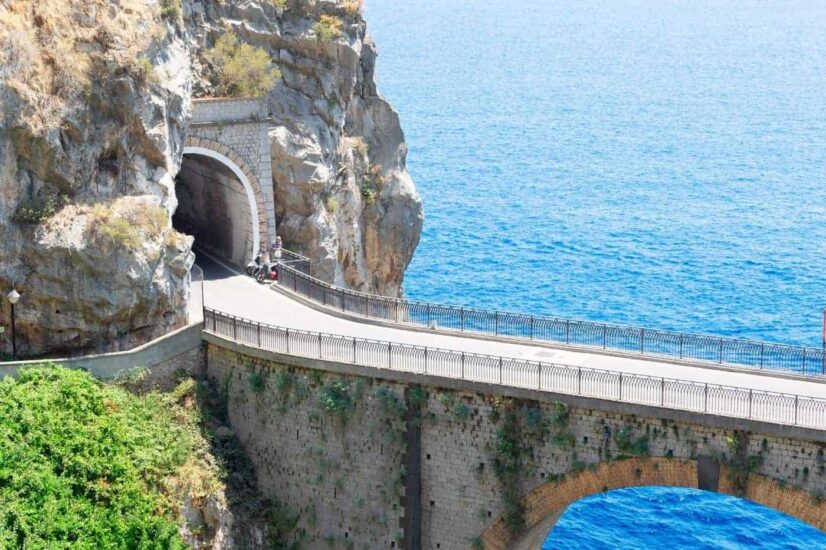
There are several ways to get to Furore by public transport with the SITA buses.
From Salerno or Naples you have to take the line to Amalfi and once at the terminus change bus, line to Positano/Sorrento, the stop is near the bridge over the fjord. From Sorrento one must take the line to Amalfi and get off at the already mentioned stop on the Fiordo bridge.
Instead, to reach Furore, high up on the slopes of the hill, you have to take the bus on the Amalfi – Agerola line.
If you are thinking of reaching the Fiordo di Furore by car, we advise against doing so, as it is not easy to park in the immediate vicinity.
Should you wish to venture out with your own vehicle, there are two solutions: you can park in Praiano, at a private car park, and proceed on foot for the two kilometres that separate you from your destination.
Alternatively, you could have lunch at one of the nearby restaurants and ask to leave your car for the time of your visit.
We do not guarantee the success of this option, as in high season it is not easy for businesses, which are thronged by travellers, to keep a parking space occupied. However, if you travel in the low season, your request may be granted.
For more tips on travelling the Amalfi Coast, please read the full article on our website.
Excursions and itineraries around Furore
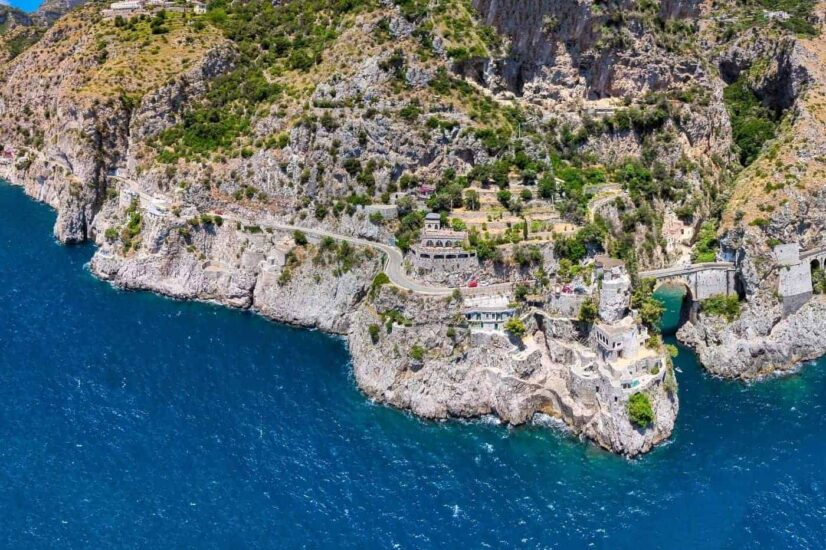
Beware, Furore is not just the well-known Fiordo. The municipality, part of the Amalfi Coast in the province of Salerno, also extends high up along the slopes of the coast to the Agerola plateau, crossed by a winding, scenic road.
The Fiordo di Furore is the jewel in the crown of eco-tourism, or the experience of travelling in full respect of nature.
It is here that the ” Ecomuseum of the Fjord of Furore” is based, an important project for the recovery and valorisation of existing structures such as mills and water systems from distant times.
The project began in 1982 and was only completed in 2000.
The Ecomuseum project is important because it aims to enhance the unique identity of the Fjord of Furore and is structured in different sections such as the herbarium and the celestial classroom.
At the guided tour centre there are operators always ready to set out to discover the Fiordo di Furore and its secrets.
In the upper village, not to be underestimated are the religious itineraries to discover interesting buildings such as the Church of San Giacomo, which preserves intact its ancient characteristics.
Through some notarial documents, it has been possible to establish that the Church is the oldest in the Fjord of Furore and that it was consecrated to St. James because it stood on the locality “Sancti Jacobi de Casanova”.
The Church of San Michele, on the other hand, has a characteristic asymmetrical entrance, which, according to experts, was created after the enlargement of the left aisle.
Finally, the single-nave Church of Sant’Elia is worth a visit, with various stratifications still being studied, from which one of the most popular itineraries for hikers starts, the ‘passeggiata dell’amore’ (love walk) that leads to the Belvedere of Praiano, where you can enjoy a romantic view of the Amalfi Coast.
There are many paths crossing the territory of Furore, some of them very interesting. Among the most spectacular are: the ‘Abu Tabela Path’, a 50-minute walk that starts from the Pino area and arrives at San Lazzaro, taking the traveller in the footsteps of General Avitabile.
The “crow’s nest path”, on the other hand, is slightly longer and starts in Centena and arrives in Bomerano di Agerola.
Amidst pergolas and hazelnut groves, it treads the same ground as the brigands, and from the ridge you can glimpse the ruins of the Hermitage.
For the daredevils, however, there is the ‘Path of the Crazed Bats’, which lasts 30 minutes. It starts at the Fiordo di Furore and arrives at Punta Tavola, passing through dense vegetation leading to the old paper mill, inhabited by bats and shrouded in a sinister and mysterious air.
Decidedly softer is the “Path of the flowering agave”, which in an hour and a half takes you from Punta S. Elia to Marina di Praia among the cliffs and briefly meets the “passeggiata dell’amore” (love walk).
Amidst agaves and prickly pears, huge carob trees and rosemary, the atmosphere is enchanting even if the path is rather impassable and you need suitable shoes to reach the finish line.


